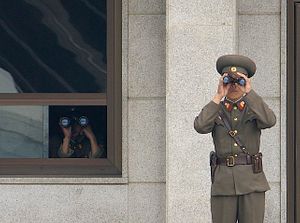With miles of barbed fence, bright signs warning of hidden landmines, and intimidating guards in full North Korean military garb observing at all times, the Demilitarized Zone (DMZ) conjures a whole range of scary images. The DMZ, just 2.5 miles (4 kilometers) wide, spans the official border separating the two Koreas, and serves as a stark reminder that the two halves of the peninsula have technically been at war for nearly 70 years. But with the recent thaw between the North and South Korean governments, the DMZ is going through a major rebranding, turning from a symbol of war to a nature destination.
Plans to turn the DMZ into some sort of peace park have been floating around for years, and scientists have long noted the vibrant growth of flora and fauna in the area thanks to its decades-long protection from human interference. But despite some sporadic cooperation, particularly among conservationists, these calls went largely unheeded over the years as tensions between the two Koreas continued to simmer. Now, negotiations between North and South Korea as well as North Korea and the United States may have largely stalled, but progress is still being made in the DMZ.
In April 2018, South Korean President Moon Jae-in and North Korean leader Kim Jong Un first met and agreed to “transform the demilitarized zone into a peace zone in a genuine sense by ceasing as of May 1 [2018] all hostile acts and eliminating their means, including broadcasting through loudspeakers and distribution of leaflets, in the areas along the Military Demarcation Line.” Since then, the two sides have not only stopped propaganda at the border, they have dismantled several guard posts and conducted extensive mine-clearing operations to remove some of the estimated 2 million landmines that litter the DMZ. In addition, mine clearing missions have led to the discovery of the remains of several soldiers who were killed during the Korean War but who remained undiscovered for decades in the border’s dangerous no-go zone.
The latest sign of progress is the opening of new hiking trails in the area, part of Moon’s plan to demystify the DMZ and turn it into a zone of peace instead of division. The first hikers to explore the new track climbed 2 kilometers on the Goseong DMZ Trail at the end of April, and a second trail will open on June 1. All hikes are accompanied by military guides, and are limited to small groups leaving twice a day. According to Korea Bizwire, the tours are already filling up weeks in advance, particularly on weekends and holidays.
Although the opening of these new trails is a promising sign of de-escalation, officials have not forgotten the wartime backdrop of this new engagement strategy. UN, Korean, and U.S. military forces, which are in charge of maintaining security on the southern side of the DMZ, had to give official approval for the peace trail project to protect both visitors and soldiers still stationed in the area.
“United Nations Command (UNC) and the ROK government have demonstrated superb teamwork, collaboration, and coordination throughout the entire ‘peace trail’ process and will continue to do so,” General Robert B. “Abe” Abrams, commander of United Nations Command, Combined Forces Command, and U.S. Forces Korea, said in a statement after approving the plan. “The ROK military has worked extremely long hours to ensure the success of this very important initiative, while assuring visitors their safety remains paramount.”
Particularly after the anti-climactic ending of the Hanoi Summit between Trump and Kim in February, observers have bemoaned the lack of progress on U.S.-Korea relations. But with the small but concrete steps that the two Koreas are making to open the DMZ and reduce tensions at the spot where the two sides directly face each other across the border, perhaps there is more progress being made than it may appear at first glance.
Jenna Gibson is a doctoral student in political science at the University of Chicago and a Korea blogger for The Diplomat. You can find her on Twitter at @jennargibson.

































